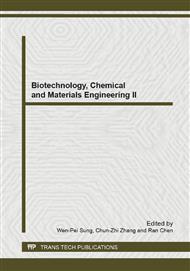p.947
p.951
p.955
p.959
p.962
p.967
p.971
p.975
p.979
Study on Autotoxicity of Aqueous Extracts from Different Parts of Flowering Chinese Cabbage
Abstract:
Autotoxicity of aqueous extracts from roots, stems and leaves of flowering Chinese cabbage (Brassica campestris L. ssp. chinensis var. utilis Tsen et Lee) were studied by hydroponic in different concentrations (0.5g/L, 2g/L, 5g/L). The results showed that in solution with aqueous extracts from roots, stems and leaves, the growth of flowering Chinese cabbage were inhibited, leaf chlorophyll content declined, photosynthesis rate were affected, activities of SOD, POD and CAT were changed, MDA concentration increased, thus cell membrane permeability of flowering Chinese cabbage was damaged. The autotoxicity of aqueous extracts in flowering Chinese cabbage increased with the extracts concentration increasing.
Info:
Periodical:
Pages:
962-966
Citation:
Online since:
January 2013
Authors:
Price:
Сopyright:
© 2013 Trans Tech Publications Ltd. All Rights Reserved
Share:
Citation:


